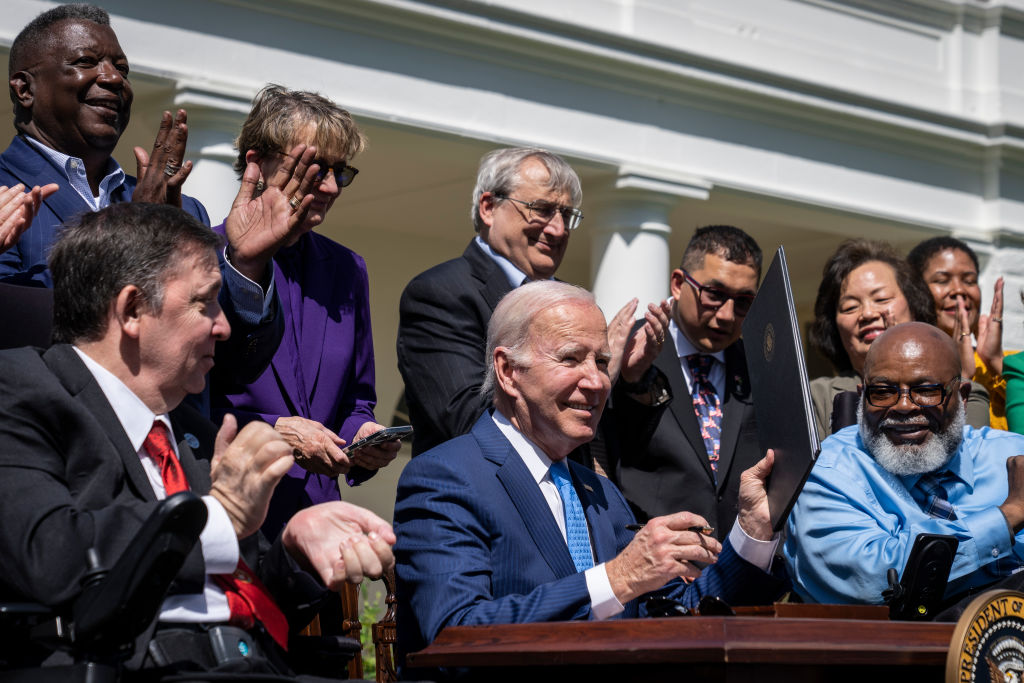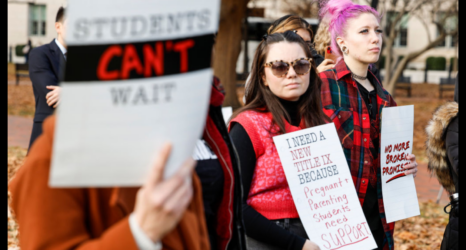Many families that receive government assistance for childcare still pay a lot out-of-pocket. A new Biden administration rule will lower those costs and improve payments to daycare providers.

This story was originally published by The 19th.
For more than a decade, Erin Farias has watched the low-income families who send children to the daycares she runs navigate America’s broken childcare system. Many of those parents had government assistance for school tuition, but half the time, Farias couldn’t count on them to make their co-payments. They were still too high.
Subsidies are supposed to make care more accessible for those with the most need, but families in many states still struggle to pay childcare bills. To be considered affordable by the Department of Health and Human Services, they must cost no more than 7 percent of a family’s income. But in more than half of states—including Michigan, where Farias runs two daycare centers—families on assistance are required to pay much more than that.
Farias said many times, she’d just eat the cost of the co-payments, or let families rack up a large balance until, eventually, she’d have to ask them to find alternate care.
“I was generous because I’m passionate about people who are at a disadvantage. I want to help those kids break through barriers and become something different. I don’t want to give up on them,” Farias said. “But I was barely making a profit, and my employees were making so little.”
Several times, those challenges led her to question whether to take on more low-income children, she said. About 40 percent of kids at Little Smiles Daycare, which Farias opened in 2013 and where she is the director, are on subsidies. Some 25 percent of kids in her second center, Little Smiles Christian Learning Center, are also low-income.
But the landscape of childcare assistance is about to change—and costs are finally coming down.
At the end of February, President Joe Biden’s administration announced it was going to require every state to cap its co-payments so that families that receive subsidies pay no more than 7 percent of their income towards childcare.
That’ll make a big difference in places like New Hampshire, West Virginia and Ohio, where those costs are eating up 18 to 27 percent of families’ budgets. Though the new rule doesn’t apply to the thousands of other families whose incomes are too high for a subsidy but are also paying exorbitant costs, it does address the acute need among the lowest-income families, most of whom are families of color. More than 100,000 families are expected to benefit.
With the change, families are expected to save about $200 a month on average, according to the White House. The new rule is effective April 30. Some states will be able to make the changes quickly; others will need approval from their legislatures. All will need to be in compliance by 2026.
“The affordability is key—that one is always the hardest thing that families are experiencing,” said Nina Perez, the early childhood national campaign director at MomsRising, a national network pushing for childcare and other family policies. “It won’t be the same in all states, but how amazing that in some of the states where folks are struggling the most, this will make an impact.”
The Biden administration announced last summer that it was looking at ways to cut childcare costs by making updates to the Child Care and Development Block Grant, the federal daycare funding system. The block grant sends federal dollars to states to help cover the cost of care for those in need—about 800,000 families. The administration proposed changing some parameters of the grant, specifically improving savings for families and boosting payments for providers to stabilize an ailing childcare system.
Childcare has been in crisis for years, but COVID-19 took the industry to the brink of collapse. Daycares shuttered, and it took the childcare workforce nearly four years to recover to pre-pandemic levels. Congress passed additional childcare assistance during the pandemic that temporarily helped keep centers open, but those funds ended in September.
During the pandemic, states used the additional funding to test out new ways to improve their childcare systems, or to cap or entirely eliminate families’ co-payments and improve provider pay structures. Both were popular changes that will now be made permanent for all low-income families and the daycares that serve them.
Only about 14 percent of families eligible for the childcare subsidies are actually enrolled in the program, according to a report from the First Five Years Fund, a childcare and early learning advocacy group. Co-payments are part of the reason why: Between 2005 and 2021, the cost of co-pays rose at a faster rate than inflation, increasing about 18 percent, the Administration for Children and Families found.
Because of those high co-pays, low-income families that qualify for the program haven’t used it, said Anne Hedgepeth, the chief of policy and advocacy at Child Care Aware, a national advocacy group. Instead, those families may be putting their children in more informal care, or losing the opportunity to work because they don’t have childcare at all.
“The sheer existence of a co-pay is, for some families, a barrier,” Hedgepeth said. “Even if it’s only 100,000 families who will see a decrease, that’s still 100,000 families for whom scraping together that co-pay may have been challenging.”
The affordability is key—that one is always the hardest thing that families are experiencing.
Nina Perez, MomsRising
Improving stability for providers is the other part of the equation. The new rule would iron out a disparity between how families that use the subsidy—and higher-income ones that don’t—pay for care. That change could ensure that daycares receive funding sooner and more regularly, making it easier for them to budget and hire staff.
Families outside the subsidy system pre-pay when they enroll in childcare, and their tuition doesn’t change if a child misses a day because they got sick, for example. But that’s not how it works for students on subsidies in half of U.S. states. For those kids, states pay the childcare providers based not on enrollment but on the children’s daily attendance—and that comes after the care is rendered. That means providers might base their budget on expectations for consistent attendance, but receive less money than expected if attendance drops.
And kids miss childcare often, especially due to sickness. But daycares have fixed costs they need to cover, including payroll and rent. It’s hard to manage those when state payments fluctuate and can result in a shortfall.
The rule change will require states to use the same payment structure for both higher-income families and those on subsidies. About 140,000 childcare centers and in-home daycare providers are expected to benefit, according to the White House.
“I don’t think we can [overstate] the importance of the changes around payment practices for providers,” Hedgepeth said. The change could encourage more providers to participate in the subsidy program because they know they’ll be paid consistently for serving low-income students in the same way they are for other children.
It’s really encouraging to see something is being done, instead of nothing.
Brittany Gregory, a mom in North Carolina
About 73 percent of childcare directors and administrators said they’d be more likely to accept families using subsidies if they were paid based on enrollment, according to an August survey by the National Association for the Education of Young Children, a childcare advocacy group.
Farias said changing billing practices during the pandemic was transformational for the health of her business. At that time, Michigan used the temporary childcare funding to switch to an enrollment-based billing model, a change the state made permanent.
Pandemic-era funding is the reason both of her centers are still open, especially the shift to enrollment-based billing, Farias said. “It was almost traumatizing imagining going back.”
For her business, the new rule “is going to change everything,” she said. She’ll be able to better serve more low-income families, and the more consistent funding could also help her improve pay for her staff.
The new rule also makes recommendations about other changes states can choose to adopt to bolster their childcare sector. Among the key recommendations is a better digital application process—17 states still use paper forms—and more prominently informing parents about what exactly their co-payments would be.
States are encouraged to further lower co-payments or waive them entirely for certain families, such as those that are very low-income, experiencing homelessness or who have children in foster care or with disabilities.
“We hear a lot from families of children with disabilities who have just not been able to find care. Or the childcare that you can find is so high-cost because the providers have to account for the cost of higher need,” Perez said. “Those are some of the hardest hit on childcare, and I think that is a piece here that is really significant.”
Brittany Gregory, a mom in North Carolina whose 3-year-old receives childcare assistance, said she thought she understood the subsidy system thanks to her work at a children’s nonprofit. But when she had to apply for a subsidy herself, she realized for the first time “how convoluted” the system was. Few centers accepted children on subsidies and the co-payments were higher than she expected. Changes that would make it easier for parents to go through the process are sorely needed, she said.
Gregory has a small co-pay—about 1 percent of her family income—but she said she’s heartened to see change coming for families.
“It’s really encouraging to see something is being done, instead of nothing,” Gregory said.
How much states will do based on the new rule will come down to funding, however. The rule doesn’t come with any additional funds, which means existing money will have to be shuffled from other parts of the childcare system.

State legislatures can choose to add funding beyond what the federal government has allocated, as states like New Mexico have done. But making the case that childcare is a priority among other competing needs has been an ongoing challenge.
For years, states have struggled to come into compliance with the requirements of the Child Care and Development Block Grant, with some still years past the deadline for compliance on safety issues. Funding is at the heart of that—and this—story.
In Ohio, the state with the highest co-payments, at 27 percent of family income, advocates worry whether the state will be able to comply. Ohio was already ordered by the federal government to improve its payment rates for providers in order to increase childcare options for low-income families who receive assistance. Now, it will also have to cover most childcare costs for those families.
“Who is actually going to take on the burden of this change? And right now in Ohio, at least, it’s very consistently been childcare providers, because our state legislature has not consistently invested the funding in order to help us expand our childcare program in a healthy way,” said Kathyrn Poe, the budget researcher with Policy Matters Ohio, a non-profit policy research institute.
A spokesperson for the Ohio Department of Children and Youth, which manages the childcare program, wrote in a statement that Ohio is “currently comprehensively evaluating the new federal requirements against current rules and processes to assess potential impact and required changes.” The department anticipates applying for the two-year waiver allowed as part of the rule to get more time to make the changes, which means they likely won’t be in place until 2026.
Ultimately, what’s happening in Ohio’s childcare system is a lot of stakeholders “squabbling over the same crumbs,” said Ali Smith, the operations specialist and worker center network liaison at Policy Matters Ohio.
How well the state is able to allocate funds to actually comply with the new regulation will determine how widespread its impact is.
“When the federal government actually does something like this, we need them to ask states and really monitor how those funds are being spent,” Poe said. “Because in a state like Ohio, we’re already seeing that risk is there for them not to be completely implemented the way that I think the federal government is actually thinking of.”
Up next:
U.S. democracy is at a dangerous inflection point—from the demise of abortion rights, to a lack of pay equity and parental leave, to skyrocketing maternal mortality, and attacks on trans health. Left unchecked, these crises will lead to wider gaps in political participation and representation. For 50 years, Ms. has been forging feminist journalism—reporting, rebelling and truth-telling from the front-lines, championing the Equal Rights Amendment, and centering the stories of those most impacted. With all that’s at stake for equality, we are redoubling our commitment for the next 50 years. In turn, we need your help, Support Ms. today with a donation—any amount that is meaningful to you. For as little as $5 each month, you’ll receive the print magazine along with our e-newsletters, action alerts, and invitations to Ms. Studios events and podcasts. We are grateful for your loyalty and ferocity.





